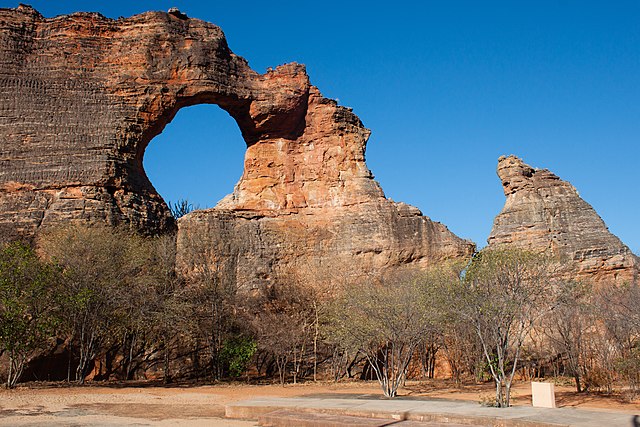Top Qs
Timeline
Chat
Perspective
Serra da Capivara National Park
National park of Brazil From Wikipedia, the free encyclopedia
Remove ads
Serra da Capivara National Park (Portuguese: Parque Nacional Serra da Capivara, IPA: [ˈpaʁki nɐsjoˈnaw ˈsɛʁɐ dɐ kɐpiˈvaɾɐ]) is a national park in the Northeastern region of Brazil. The area has many prehistoric paintings.
The name of the mountain range that defines the park, "Serra da Capivara," literally means "Capybara Hills" in Portuguese. This area has the largest and the oldest concentration of prehistoric sites in the Americas.[1][2] Scientific studies confirm that the Capivara mountain range was densely populated in the pre-Cabraline Era.[3]
Remove ads
Location
It is located in northeast state of Piauí, between latitudes 8° 26' 50" and 8° 54' 23" south and longitudes 42° 19' 47" and 42° 45' 51" west. It falls within the municipal areas of São Raimundo Nonato, São João do Piauí, Coronel José Dias and Canto do Buriti. It has an area of 1291.4 square kilometres (319,000 acres).
The Capivara-Confusões Ecological Corridor, created in 2006, links the park to the Serra das Confusões National Park.[4]
Remove ads
History

The park was created to protect the prehistoric artifacts and paintings found there. It became a World Heritage Site in 1991. Its head archaeologist was Niède Guidon. Its best known archaeological site is Pedra Furada.
Scientific studies confirm that the Capivara mountain range was densely populated in the pre-Columbian Era.[citation needed] A newer site is Toca da Tira Peia, where the stone tools found may date to as early as 22,000 years ago. The site has been dated through optically stimulated luminescence.[5]
Other important archaeological sites in the area are Toca da Pena, Baxao da Esperanca, and Sitio do Meio. Lapa do Boquete site is located directly south.[6]
Remove ads
Wildlife
Bearded capuchins in the park have been found to have the "largest known tool kit for wild capuchin monkeys".[7] Their stone tools include those for foraging, threat, and sexual displays, while they use sticks as tools for probing. Further, while on the ground, they dig with their hands after loosening the soil with stone tools for roots and arthropods.[7]
Sítio do Meio
Sítio do Meio is the second most important rock shelter in the area after Pedra Furada. It features fully Pleistocene dates and artefacts. The stone artefacts are better preserved because of the absence of waterfalls. At least 98 stone tools seem older than 12,500 BP. They belong to the Upper Pleistocenic phase of Pedra Furada 3.[8]
See also
References
Bibliography
External links
Wikiwand - on
Seamless Wikipedia browsing. On steroids.
Remove ads







